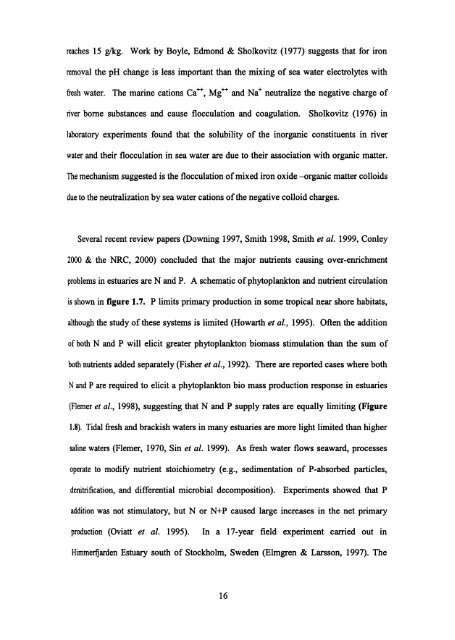Salinity Intrusion and Seasonal Water Quality Variations in the Tidal ...
Salinity Intrusion and Seasonal Water Quality Variations in the Tidal ...
Salinity Intrusion and Seasonal Water Quality Variations in the Tidal ...
Create successful ePaper yourself
Turn your PDF publications into a flip-book with our unique Google optimized e-Paper software.
eaches 15 g/kg. Work by Boyle, Edmond & Sholkovitz (1977) suggests that for iron<br />
removal <strong>the</strong> pH change is less important than <strong>the</strong> mix<strong>in</strong>g of sea water electrolytes with<br />
fresh water. The mar<strong>in</strong>e cations Ca++, Mg++ <strong>and</strong> Na+ neutralize <strong>the</strong> negative charge of<br />
river borne substances <strong>and</strong> cause flocculation <strong>and</strong> coagulation. Sholkovitz (1976) <strong>in</strong><br />
laboratory experiments found that <strong>the</strong> solubility of <strong>the</strong> <strong>in</strong>organic constituents <strong>in</strong> river<br />
water <strong>and</strong> <strong>the</strong>ir flocculation <strong>in</strong> sea water are due to <strong>the</strong>ir association with organic matter.<br />
The mechanism suggested is <strong>the</strong> flocculation ofmixed iron oxide -organic matter colloids<br />
due to <strong>the</strong> neutralization by sea water cations of<strong>the</strong> negative colloid charges.<br />
Several recent review papers (Down<strong>in</strong>g 1997, Smith 1998, Smith et al. 1999, Conley<br />
2000 & <strong>the</strong> NRC, 2000) concluded that <strong>the</strong> major nutrients caus<strong>in</strong>g over-enrichment<br />
problems <strong>in</strong> estuaries are N <strong>and</strong> P. A schematic ofphytoplankton <strong>and</strong> nutrient circulation<br />
isshown <strong>in</strong> figure 1.7. P limits primary production <strong>in</strong> some tropical near shore habitats,<br />
although <strong>the</strong> study of<strong>the</strong>se systems is limited (Howarth et al., 1995). Often <strong>the</strong> addition<br />
of both N <strong>and</strong> P will elicit greater phytoplankton biomass stimulation than <strong>the</strong> sum of<br />
both nutrients added separately (Fisher et al., 1992). There are reported cases where both<br />
N<strong>and</strong> P are required to elicit a phytoplankton bio mass production response <strong>in</strong> estuaries<br />
(Flemer et al., 1998), suggest<strong>in</strong>g that N <strong>and</strong> P supply rates are equally limit<strong>in</strong>g (Figure<br />
1.8). <strong>Tidal</strong> fresh <strong>and</strong> brackish waters <strong>in</strong> many estuaries are more light limited than higher<br />
sal<strong>in</strong>e waters (Flemer, 1970, S<strong>in</strong> et al. 1999). As fresh water flows seaward, processes<br />
operate to modify nutrient stoichiometry (e.g., sedimentation of P-absorbed particles,<br />
denitrification, <strong>and</strong> differential microbial decomposition). Experiments showed that P<br />
addition was not stimulatory, but N or N+P caused large <strong>in</strong>creases <strong>in</strong> <strong>the</strong> net primary<br />
production (Oviatt et al. 1995). In a 17-year field experiment carried out <strong>in</strong><br />
Himmerfjarden Estuary south of Stockholm, Sweden (Elmgren & Larsson, 1997). The<br />
16

















